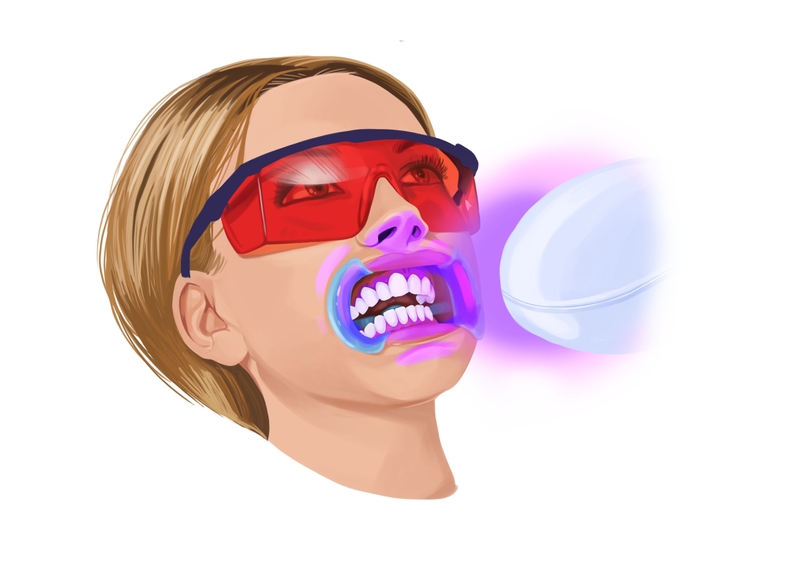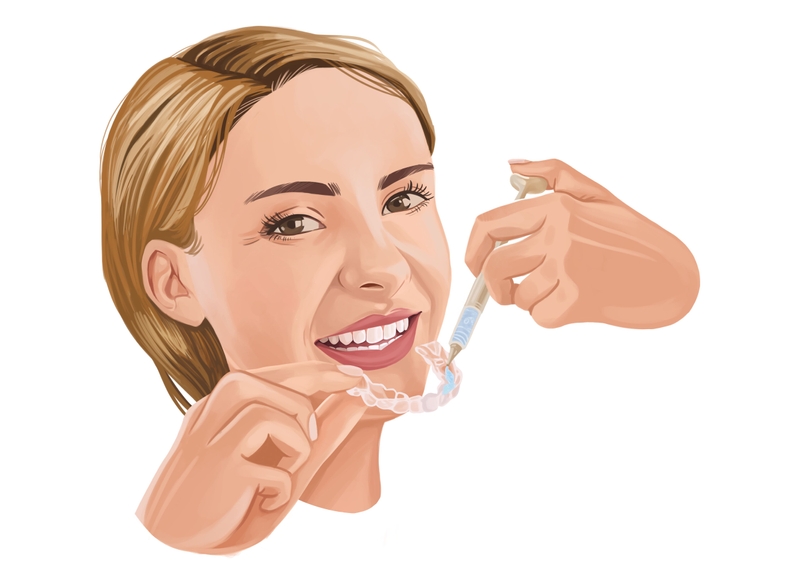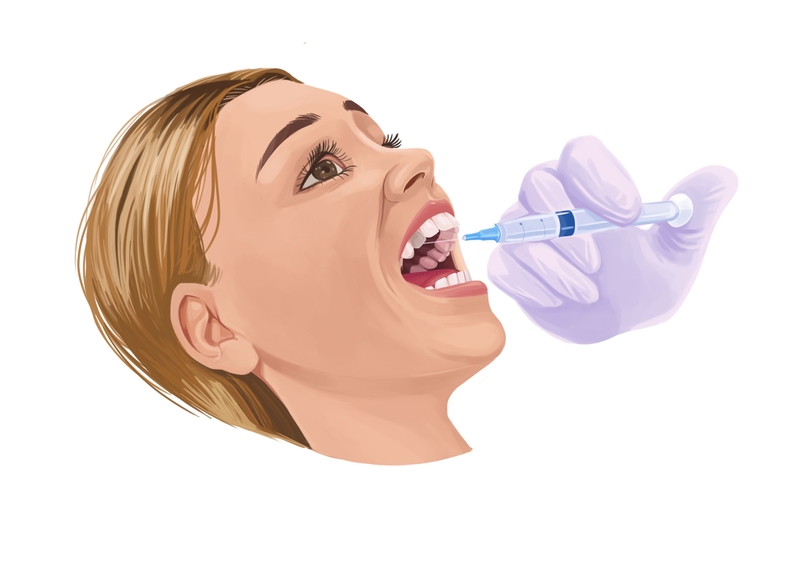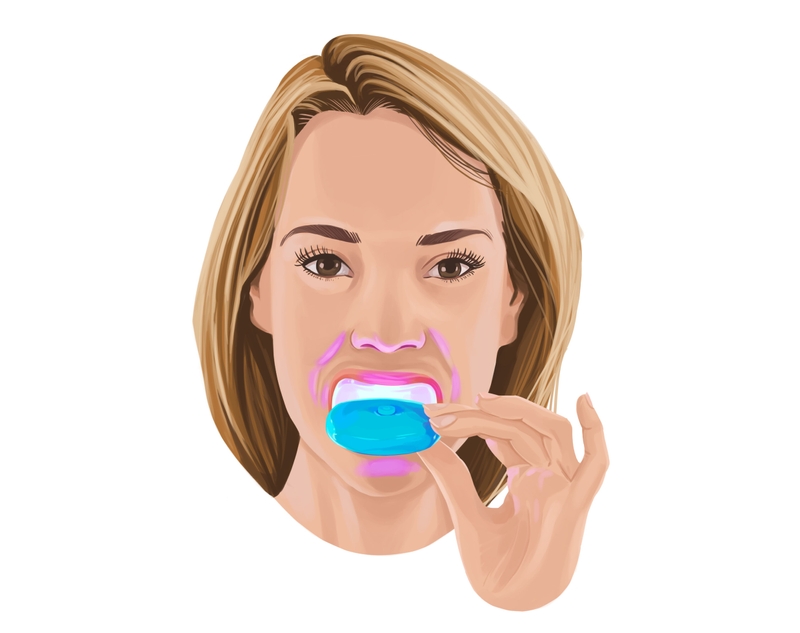- Extrinsic factors that cause tooth discoloration are smoking, tea, wine, coffee, and soft drink consumption. Intrinsic factors are medications, genetics and aging.
- Teeth whitening involves breaking down stains and reducing the concentration of staining.
- Common whitening methods include external bleaching at the dentist's office, external bleaching for home use, internal bleaching, and at-home teeth whitening with products from OTC.
Say hello to your new confident smile. Use Authority Dental to find the best dentist nearby. It’s easy, fast and free.
Do you want to have whiter teeth? Here's everything you need to know.
What causes discolored teeth?

Picture by Authority Dental under CC 2.0 license
There are three types of causes that influence the color of your teeth:
extrinsic,
intrinsic, and
age-related.
Extrinsic factors may make your teeth appear brown or even purple. They are things that stain your teeth by coming in contact with them. Here are some things that fall into this category:
drinking tea, wine, coffee, and soft drinks,
eating some foods like citrus fruits and starchy meals,
smoking and ingesting tobacco,
poor dental hygiene, and
excessive use of fluoride.
Intrinsic factors come from the inside of your body. They can make dentition look grey or have black spots. These include:
diseases,
treatment like radiation and chemotherapy,
pregnancy,
certain medications,
amalgam restorations,
death of the pulp, and
genetics.
And lastly, patients often experience tooth discoloration as they age. Older people tend to have yellower teeth.
How does teeth whitening work?
Gels and serums that are used to whiten teeth contain active substances that bleach the teeth. This is most commonly either hydrogen peroxide or carbamide peroxide. They break stains down, making the coloration less concentrated and teeth become whiter.
Those two compounds may be harsh on other parts of your mouth. This is why protection is applied to gums and lips. Products designed for home use have much lower concentrations to prevent patients from burning their mouths. This also means that these effects won’t be as visible as professional treatment.
LED and other types of lamps may be used to aid the process. They don’t actually whiten the teeth. Those devices simply speed up the process, by making the active ingredients break down quicker.
Teeth whitening methods
There are 4 main ways to whiten teeth. You will most likely make your choice based on how quickly you want to see the effects and what cost of teeth whitening you are willing to cover.
External in-office bleaching

Picture by Authority Dental under CC 2.0 license
External means whitening the tooth from the outside, rather than from the inside. It is less complicated than internal bleaching.
Before this teeth whitening service, your dentist will first conduct an exam with X-rays to make sure you are a candidate.
A whitening product is then applied. Lasers and LED devices are often used to speed up the process.
Going with professional bleaching is the fastest way to whiten teeth. Specialist care reduces the risk of side effects. Teeth whitening for sensitive teeth should always happen in-office.
External bleaching for home application

Picture by Authority Dental under CC 2.0 license
Take-home kits are a compromise between OTC products and having your teeth whitened in-office. It is still a lot safer than working completely on your own, as the dental professional can choose the correct product and adjust the dosage.
You will need a personal assessment on whether you qualify for bleaching at all. If you do, a custom teeth whitening tray will be made. It will fit your mouth perfectly and ensure even coverage of the product.
The solution will be stronger than what you might get online or at the drugstore. You will probably get a set of trays and gel-filled syringes. Sometimes the kits consist of pre-filled trays only.
This treatment is cheaper than whitening your teeth in the office, as you spend less time “in the chair”. This means that the dentist will not have to be compensated for as much of their time.
Internal bleaching

Picture by Authority Dental under CC 2.0 license
Internal bleaching is a strictly professional teeth whitening process. It must be done by a skilled dentist. The procedure involves drilling a small hole inside a discolored tooth and inserting a bleaching solution. A temporary filling closes off the hole and the process can be repeated as necessary.
This method of whitening is meant for singular teeth that have become discolored due to, mainly, root canal work. Other indications include necrosis (discolored dead teeth) or intrapulpal haemorrhage (bleeding inside the tooth).
Internal bleaching can only be done at the office and may require up to 6 visits. It involves a lot of "meet, greet, and seat" time.
Teeth whitening at home (OTC products)

Picture by Authority Dental under CC 2.0 license
You can whiten your teeth at home using whitening pens, strips, mouthwash, or toothpaste available online and at drugstores. OTC products that have recently gained a lot of interest include a teeth whitening kit with a gel and LED light.
Those teeth whitening products contain the same active ingredients as in-office substances but in smaller concentrations. Effects will be visible after a few weeks of use.
There are also alternative methods, for example charcoal, coconut oil, and baking soda, but dentists usually advise against them.
The downside of whitening your teeth out of office is that side effects such as sensitivity and gum irritation are more common. Strips and other applicators are made to be universal, which means the coverage won’t be as even as with trays made by a dentist.
FAQ
Is whitening and bleaching the same procedure?
Yes, those are two terms used to describe the same type of treatment.
Does whitening work on all teeth?
Whitening will not work on dental work and restorations such as crowns, veneers, and dentures. Teeth that are stained by tobacco may not react as well as you would like.
Gray and purple spotting on dentition is also hard to remove.
Is teeth whitening safe?
There is some risk to tooth whitening. Sensitivity is an almost sure side effect, but that goes away with time. The same goes for gum irritation. It is usually caused by faulty trays or uneven coverage of the whitening product.
Complications are more likely if you bleach your teeth often. The most important thing is to avoid ingesting the product. This can have detrimental effects on your stomach lining and digestive system.
Nonetheless, bleaching teeth is safe if you are a good candidate. That means you must not have any major issues in your mouth or be pregnant. You can wait until after you’ve had a baby and target the problems in your mouth before starting treatment.
Dental work such as crowns and bridges may also be an issue. Think about whitening before having them installed. Otherwise your whiter teeth may be a different color to your crown, filling, bridge, or veneers.
What to do for pain after teeth whitening?
Use desensitising products such as toothpastes and mouthwashes. There are numbing gels available at drug stores as well. These help sensitive teeth after whitening as well as before, so you may use these prior to your treatment as well.
How long does teeth whitening last?
The appointment may take about an hour. Results last anywhere from 3 months up to 3 years. This depends on the condition of your teeth and the bleaching method.
Home teeth whitening may have shorter effects that will appear after a few weeks of use.
How to take care of whitened teeth?
As always, brush and floss your teeth twice a day. Your teeth may be sensitive for a few weeks, so desensitizing toothpaste (before and after treatment) is a good idea. You can also supplement the procedure by using whitening products. Stay away from foods and drinks that stain teeth such as wine and tea.
What to eat after teeth whitening?
Try to stick to white vegetables and non-acidic fruits for a while. Those won’t stain your teeth and will keep you full of vitamins. Avoiding foods that are dark is key.
Eric Moryoussef, DDS
Overall, studies have shown that both substances work equally well, however products with carbamide peroxide have a higher concentration. A product with 30% carbamide peroxide is equivalent to 10% hydrogen peroxide.